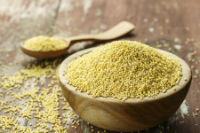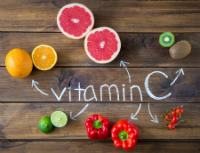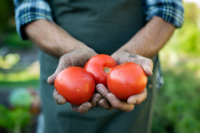December 2019 Edition
What’s New
The average person eats more than 7,000 calories on Christmas day, research carried out by Associated British Foods recently found. That’s more than three times the U.S. Department of Agriculture’s recommended daily caloric intake.
Holidays: The Healthy, Homemade Way

You’ve heard the saying, “it’s the thought that counts.” This year, make your thoughts count with healthy homemade gifts. Do-it-yourself (DIY) gifts allow you to avoid the toxins that lurk in most store-bought products, save money, and promote the wellbeing of friends and family. As an added bonus, making gifts is a fun way to exercise creativity and relieve stress. In the spirit of the season, here are DIY gift ideas that are sure to boost the health and mood of everyone on your list.
Infused Oils. The cooks in your life will devour these infused oils, bottled with love. Place dried herbs of your choice in a sterilized, dry jar and cover with olive oil. Place the jar in a saucepan and fill the pan about a quarter full of water. Gently heat the herbs over very low heat, between 100° and 120° F for one to five hours, until the oil takes on the color and scent of the herb. Remove the jar and cool completely before labeling. Get creative with your label; be sure to date the mixture and list the ingredients.
Aromatherapy Bath Salts. Mix together one cup Epsom salt, a half-cup natural sea salt, 20 to 30 drops of your favorite essential oil and two to three tablespoons of dried herbs or botanicals. Transfer into a glass jar. Decorate the jar with paint markers or attach a creative label. Include directions: add a half-cup of bath salts to warm running bath water, submerge body, and relax!
Healthy Homemade Granola in a Jar. For people on-the-go, give a gift that will keep them energized and running at peak performance. There are tons of homemade granola recipes on the internet, and you can pick any one of them. Be sure to use organic, additive-free ingredients. All this gift takes is a trip to your local natural grocery store, a mixing bowl, an oven, and a jar to put it in. Suggested mix: Dried cherries, pineapple, and cranberries, almonds and cashews, toasted oats, and cacao nibs.
Natural Skin Care Mask. Help the women in your life beat dull winter skin with an all-natural skin care mask made of cranberries and yogurt. Simply puree a half-cup of cranberries in a food processor, transfer the puree into a bowl and mix with a half-cup of yogurt; blend by hand until you have a creamy mixture. For a thicker mask, mix in a little green clay or honey. Bottle the mixture and add a label with instructions to let the mask sit on the face for 20 minutes before rinsing with warm water. High in antioxidants, vitamins A, C, B3 and B5, cranberries not only lend moisture for the skin, they also aid in cell turnover and protect from free radicals, giving an anti-aging effect.
Herb Garden Markers. Perfect for the gardeners – and wannabe gardeners – in your life, these stones are super simple and inexpensive to make. Collect a variety of smooth riverbed stones, clean thoroughly, and on each rock paint the name of a garden herb or vegetable. Feeling extra-creative? Paint little garden-themed designs on them as well.
Food for Thought. . .
“The holidays are only holy if we make them so.” – Marianne Williamson
Ancient Grains, Modern Health Benefits

We’ve all heard about the health benefits of eating whole grains – those that have been minimally processed and are void of added sugars and preservatives. You also may be hearing about Ancient Grains. For clarity, most grains have been around since the dawn of time. What makes a whole grain an “ancient” grain is the fact that they have remained unchanged, i.e. have not been genetically modified by humans, over centuries. Modern wheat, then, is not an Ancient Grain.
There are many types of Ancient Grains and none are native plants of North America, though these “supergrains” are gaining popularity for their unique flavors and specific nutrient profile. Here are a few:
Amaranth is gluten-free, rich in fiber, potassium, calcium, iron and protein (9 grams per cup). It’s often prepared like oatmeal or can be prepared like rice. Amaranth flour is often used in baking bread.
Farro is a form of wheat (so it contains gluten), rich in B-vitamins, protein, and high in fiber but low in calories. It’s great to use in risotto style dishes.
Kamut packs 11 grams of protein in a cup. It contains gluten and resembles whole grain rice, but is more nutrient rich, containing fiber, polyphenols, and minerals.
Millet is a gluten-free yellow grain that resembles cous-cous (which is not gluten-free). Packed with magnesium, it can be steamed like rice or prepared the same as a pastina.
Teff is gluten-free, often used in making polenta. The grain is tiny, like poppy seeds, but more nutrient dense, containing iron, fiber, and calcium.
To learn more about the varieties of Ancient Grains, including those that are gluten-free, visit these resources:
The Whole Grain Council: Ancient Grains
The Whole Grain Goodness of Modern and Ancient Grains (Harvard Health)
Creamy Chicken and Kamut Casserole

Kamut? It might sound like it, but it’s not the name of a new Muppet. Pronounced KAH-moot, it is the name of a wonderful Ancient Grain that adds great flavor and texture to this recipe – a unique spin on a basic chicken and rice casserole. Kamut is slightly larger than rice and a bit chewier, with a mild nutty taste. Packed with protein, you can easily use kamut with meatless dishes. It takes a bit longer to cook than long-grain brown rice, but the taste is so worth the wait!
Ingredients
- 2 cups cooked kamut (1 cup uncooked, about 180g; see note for cooking)
- 1 1/2 cups (355ml) cashew milk (or a dairy-free milk of your choice)
- 3 Tbsp all-purpose gluten-free flour
- 1 tsp kosher salt
- 1 tsp fresh thyme
- 1 1/2 Tbsp sunflower oil
- 8 oz (225g) chicken breast, chopped into small pieces
- 1/2 small onion, chopped (about 1/3 cup)
- 2 cloves garlic, minced
- 1/2 large red pepper, chopped
- 4 cups chopped collard greens, about 6 large leaves
Preparations
- Whisk milk, flour, salt, and thyme together until there are almost no clumps left. Set aside.
- Heat the oil in a cast-iron or oven-proof skillet over medium-high heat. Add the onions and garlic, and stir constantly. Let them cook for about a minute. Add the chicken and cook it for 5-6 minutes.
- Add red pepper and collard greens and let cook for a few minutes, until the collard greens have wilted.
- Stir the milk mixture into the skillet and reduce the heat slightly (about a medium-low). Cook for a minute or two, until the mixture starts to thicken and bubble. Be sure to stir frequently because the sauce will start to burn at the bottom.
- Turn off the heat and mix in the kamut. Enjoy warm.
Vitamin C: Support for Strong Immunity and So Much More

Vitamin C, or ascorbic acid, is a water-soluble vitamin known for its role in supporting a healthy immune system. However, it’s also crucial for many other important biological functions.
A deficiency in vitamin C causes scurvy, leaves the body vulnerable to infections, and is an underlying factor in inflammation that can lead to chronic illness.
Several Key Functions That Require Vitamin C:
- the synthesis of collagen, an essential component of connective tissue and important to wound healing
- the production of certain neurotransmitters (brain chemicals)
- antioxidant support throughout the body
- facilitating the absorption of calcium into the bones
Getting Enough Vitamin C
Because our body cannot make vitamin C, it must come from the foods we eat every day. However, many of us are not eating sufficient fruits and vegetables to maintain the levels that optimally support antioxidant activity and immune function. Also, being water-soluble means that vitamin C is quickly excreted from the body. It’s important to take a daily vitamin C supplement to ensure the body has the protection it needs.
The recommended daily allowance of vitamin C is around 90 mg per day. Some research indicates a daily intake of 100-200 mg for better protection against new infections, such as colds and respiratory tract illnesses. Many experts recommend supplementing with up to 1,000 mg of vitamin C daily. However, when you are already feeling ill, it’s best to consult with a holistic physician to determine the right dose and form (liquid, capsule, etc.) for your needs. Even if you are taking a supplement, you still want to eat a variety of organic fruits and vegetables rich in vitamin C, such as:
- acerola cherries
- cantaloupe
- black currant
- lychee
- kiwi
- papaya
- pineapple
- strawberries
- red and yellow bell peppers
- broccoli
- Brussels sprouts
- cauliflower
To get the most nutrients from your fruits and vegetables, eat them as soon as possible after shopping. Consider buying local to ensure freshness, as nutrients decrease with time on the shelf. When cooking, you can limit nutrient loss by steaming or cooking on low heat for short periods of time.
Here are the vitamin C products that I recommend for my family and patients:
Phenomenal Phytonutrients

Most of us are familiar with macronutrients – protein, carbs and fat – the building blocks of a nutritious diet. But do you know that phytonutrients (chemical substances that give plants their vibrant colors) play an important role in your diet because of the ways they support good health and help prevent illness?
Plants produce phytonutrients (aka phytochemicals) to protect themselves from bacteria, viruses, and even from UV radiation from the sun. When consumed in our diet and assimilated by the human body, these substances work just as hard to protect our health. They’re especially important in the diets of athletes, weekend warriors, and those who have physically demanding jobs.
Phytonutrients have a role in:
- enhancing the health of the immune system
- counteracting inflammation in the body
- supporting communication between cells in the body
- detoxifying cells after exposure to environmental toxins
- supporting muscle activity while you are exercising, engaging in physically demanding work and during recovery.
Here are some phytonutrients and the foods they can be found in:
Polyphenols: found in berries, tart cherries, and pomegranates, which have a powerful anti-inflammatory action in the body.
Quercetin: found in apples, onions, and potato skins; works to support your immune system.
Carotenoids: found in orange and yellow produce like carrots, bell peppers, and sweet potatoes. Supports the health of eyes, skin and lungs.
Lutein and Zeaxanthin: found in green leafy vegetables including kale, spinach, unpeeled cucumber, and kiwi. Supports eye health and may protect against cardiovascular disease and certain cancers.
Many phytonutrients have more than one effect in the body. Because they help reduce inflammation and protect against disease processes, be sure to include more plant-based foods in your diet. If you have specific health concerns and want to know which phytonutrients should be a focus of your diet or supplement regimen, consult with a holistic health physician or licensed naturopathic doctor like Dr. Samm Pryce.
What is Cranial Sacral Massage?

No other structures have as much influence over the human body’s ability to function properly as the brain and spinal cord, which make up the central nervous system (CNS). The CNS is strongly influenced by the craniosacral system – membranes and fluid that surround, protect, and nourish the brain and spinal cord. A therapeutic modality known as Cranio Sacral Massage (CSM) is used to release tension and relieve pain and dysfunction.
Using a soft touch, generally no greater than the weight of a nickel, licensed massage practitioners who are trained in this modality use CSM to release restrictions in the soft tissues around the base of the skull and other regions of the head. A CSM practitioner uses his or her hands to evaluate the craniosacral system by gently feeling various locations to test for the ease of motion and rhythm of the cerebrospinal fluid pulsing around the brain and spinal cord. Soft-touch techniques are then used to release restrictions in any tissues influencing the craniosacral system.
A variety of conditions can be addressed with CSM, including;
- Chronic headache, Migraine
- Tension in the neck and back
- TMJ
- Chronic Fatigue
- Orthopedic Conditions
- Stress-related Syndromes
- Sinus Infection
Research shows that CSM is generally effective for stress and tension-related health problems, but more advanced clinical studies are needed on a wider variety of populations. Individuals who have a diagnosed aneurysm, a tumor in the head or neck, a history of concussion or head injury, or a bleeding disorder should consult their holistic health practitioner like Dr. Samm Pryce before having CSM.
Guiding Principles







